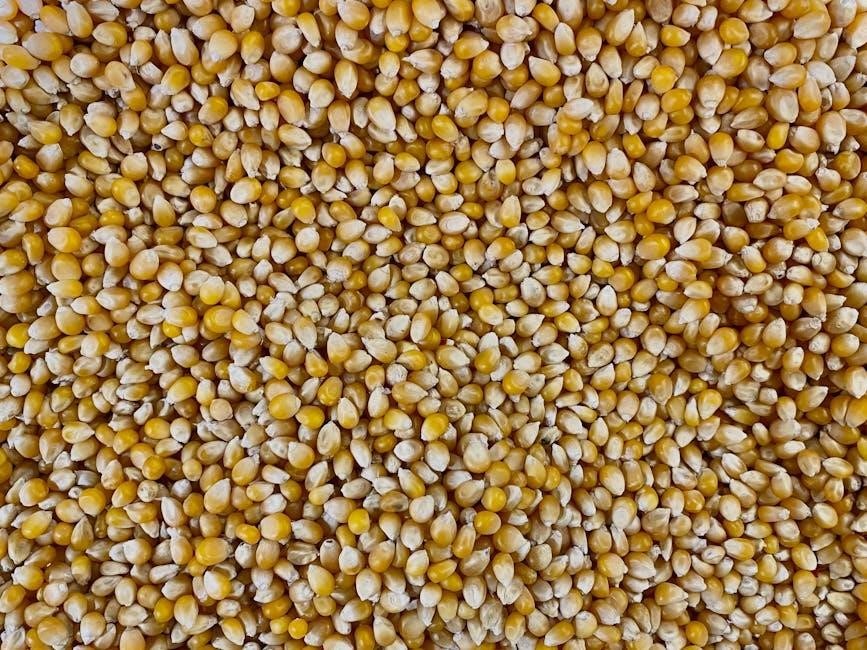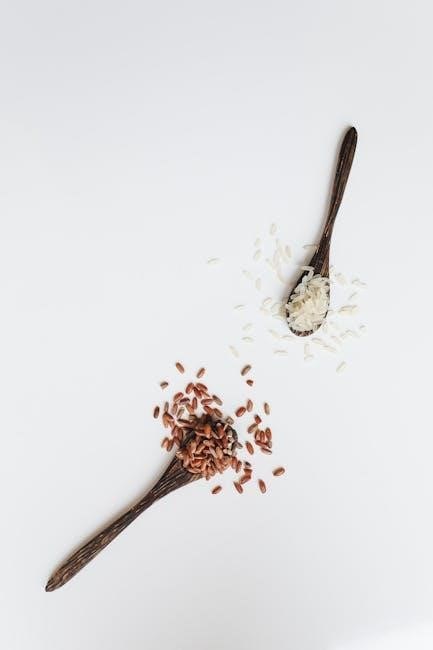Resistant starch is a unique carbohydrate that resists digestion, serving as a prebiotic for gut health. Found in grains, vegetables, and fruits, it ferments in the colon, supporting beneficial bacteria and promoting overall well-being. A resistant starch foods list PDF helps identify these foods, aiding in easy incorporation into a healthy diet.
What is Resistant Starch?
Resistant starch is a type of carbohydrate that resists digestion in the stomach and small intestine. Unlike regular starch, it is not fully broken down into glucose and instead ferments in the colon, acting as a prebiotic. This unique property allows it to feed beneficial gut bacteria, supporting gut health. Resistant starch can be naturally present in foods like green bananas, potatoes, and legumes, or formed through cooking and cooling processes, such as with cooled rice or pasta. It is a valuable component of a balanced diet, offering distinct health benefits.
Importance of Resistant Starch in the Diet
Resistant starch plays a vital role in promoting gut health by acting as a prebiotic, feeding beneficial bacteria in the colon. This supports a balanced microbiome, enhancing digestion and overall well-being. It also helps regulate blood sugar levels by slowing glucose absorption, making it beneficial for managing insulin sensitivity. Additionally, resistant starch contributes to satiety, aiding in weight management, and supports immune function. Incorporating resistant starch into meals can improve nutrient absorption and provide long-term health benefits, making it a valuable addition to a balanced diet.

Types of Resistant Starch
Resistant starch is categorized into distinct types based on sources and properties. Each type offers unique benefits, functioning differently in the body to support overall health.
RS1: Physically Inaccessible Starch
RS1 refers to starch trapped within plant cell walls, making it inaccessible to digestive enzymes. Found in whole grains, seeds, and legumes, it resists digestion due to its physical entrapment. This type of resistant starch acts as a prebiotic, feeding beneficial gut bacteria and promoting a healthy microbiome. RS1 is not significantly affected by cooking or processing, making it a reliable source of dietary fiber in whole, unprocessed foods. Its structure ensures it reaches the colon intact, where it ferments and supports gut health.
RS2: Resistant Granule Starch
RS2 is a type of resistant starch found in raw starchy foods like potatoes, green bananas, and unripe fruits. Its resistance stems from its granular structure, which prevents enzymatic breakdown in the small intestine. Cooking or processing can disrupt this structure, reducing its resistance. RS2 is a valuable prebiotic, promoting gut health by fermented by beneficial bacteria, producing short-chain fatty acids that support colon health and improve nutrient absorption. It is best consumed raw or minimally processed to retain its resistant properties.
RS3: Retrograded Starch
RS3, or retrograded starch, forms when starchy foods like potatoes, rice, or pasta are cooked and then cooled. The cooling process allows the starch molecules to recrystallize, making them resistant to digestion. This type of resistant starch acts as a prebiotic, supporting gut health by feeding beneficial bacteria. RS3 is often found in chilled or reheated starchy foods and is known for its ability to improve blood sugar control and enhance satiety. It is a versatile source of resistant starch in everyday meals.

RS4: Chemically Modified Starch
RS4 refers to starches that have been chemically altered to enhance their resistance to digestion. This modification involves treating the starch with chemicals or enzymes to create cross-links or other structural changes. RS4 is commonly found in processed foods, such as bread, pasta, and cereals, where it is added as a functional ingredient. It serves as a dietary fiber and can improve gut health by acting as a prebiotic. RS4 is also valued for its ability to stabilize blood sugar levels and enhance satiety, making it a popular choice in modern nutrition.

Natural Food Sources of Resistant Starch
Natural sources include whole grains, legumes, root vegetables, and unripe fruits. These foods retain their resistant starch content when prepared and consumed appropriately.
- Whole grains like oats and barley
- Legumes such as lentils and chickpeas
- Root vegetables like potatoes and yams
- Green bananas and plantains
Grains Rich in Resistant Starch
Whole grains are excellent sources of resistant starch, particularly when minimally processed. Oats, barley, and rice contain significant amounts, especially when cooked and cooled. Whole grain bread and pasta also contribute, though refining reduces their resistant starch content. These grains support gut health and provide sustained energy due to their slow digestion. Incorporating them into meals enhances prebiotic intake, promoting a balanced microbiome.
Vegetables High in Resistant Starch
Certain vegetables are rich in resistant starch, offering significant health benefits. Potatoes, especially when cooked and cooled, are a top source. Green bananas, though technically a fruit, also contain resistant starch. Corn, peas, and parsnips are additional vegetable options. These foods support gut health by acting as prebiotics, fostering a balanced microbiome. Incorporating these vegetables into meals can enhance digestion and overall well-being. Always choose whole, minimally processed varieties to maximize resistant starch content.
Fruits Containing Resistant Starch
Fruits like green bananas and plantains are excellent sources of resistant starch. These fruits contain higher amounts of resistant starch when unripe, as ripening breaks down some of the starch. Other fruits, such as pears, berries, and stone fruits like peaches, also contribute smaller amounts. Incorporating raw or cooked resistant starch-rich fruits into meals can boost digestive health and provide prebiotic benefits. Eating a variety ensures a steady intake and supports overall well-being. Always opt for whole, unprocessed fruits to maximize their resistant starch content.
Legumes and Beans as Sources
Legumes and beans are rich in resistant starch, making them a nutritious addition to meals. Lentils, chickpeas, black beans, and kidney beans are high in resistant starch, especially when cooked and cooled. These foods support gut health by acting as prebiotics, promoting beneficial bacteria growth. They also help regulate blood sugar levels and improve insulin sensitivity. Incorporating legumes into your diet is a simple way to boost resistant starch intake, enhancing overall digestive and metabolic well-being. They are versatile and can be added to various dishes for a nutritious, balanced diet.
Other Food Sources
Beyond grains, vegetables, and legumes, other foods rich in resistant starch include nuts, seeds, and certain processed foods. Almonds, cashews, and pumpkin seeds are good sources. Hi-maize corn, tapioca starch, and some resistant starch-enriched flours also contain high amounts. Additionally, foods like sourdough bread and some snack bars may include resistant starch due to their ingredients. These options provide variety for those looking to diversify their resistant starch intake, supporting gut health and blood sugar balance in unique ways.
Health Benefits of Resistant Starch
Resistant starch supports gut health by acting as a prebiotic, feeding beneficial gut bacteria. It also helps regulate blood sugar levels and promotes satiety, aiding in weight management.
Gut Health and Prebiotic Properties
Resistant starch acts as a prebiotic, promoting gut health by feeding beneficial bacteria like Bifidobacteria. This fermentation process supports a balanced microbiome, enhancing digestion and reducing inflammation. It increases production of short-chain fatty acids, such as butyrate, which nourish colon cells and strengthen the gut barrier. Improved gut health can lead to better immune function and reduced symptoms of digestive disorders. Incorporating resistant starch-rich foods, as listed in the PDF guide, is a simple way to support gut well-being and overall health.

Blood Sugar Control and Insulin Sensitivity
Resistant starch slows glucose absorption, reducing blood sugar spikes and improving insulin sensitivity. It delays digestion in the small intestine, preventing rapid increases in blood glucose. Studies show it enhances insulin function, lowering diabetes risk. Incorporating resistant starch-rich foods, as detailed in the PDF guide, helps regulate blood sugar levels naturally. This makes it a valuable addition to diets for managing or preventing type 2 diabetes and metabolic syndrome. Regular consumption supports long-term blood sugar balance and overall metabolic health.
Weight Management and Satiety
Resistant starch promotes weight management by increasing satiety and reducing calorie intake. It ferments in the gut, producing short-chain fatty acids that enhance feelings of fullness. This delays gastric emptying and suppresses appetite, helping maintain a healthy weight. Foods high in resistant starch, as listed in the PDF guide, support long-term weight control by improving metabolic efficiency and reducing overeating. Regular consumption aids in maintaining a balanced diet and supports sustainable weight loss efforts.
Immune System Support
Resistant starch supports immune function by fostering a healthy gut microbiome, which plays a key role in immune defense. Fermentation of resistant starch produces short-chain fatty acids, strengthening the gut barrier and reducing inflammation. This enhances immune cell activity, such as macrophages and natural killer cells, improving overall immune response. Foods rich in resistant starch, as detailed in the PDF guide, help maintain immune balance and reduce susceptibility to infections. Regular consumption promotes a robust immune system.
Practical Tips for Incorporating Resistant Starch

Cook and cool starchy foods like potatoes or rice to boost resistant starch content. Use resistant starch flours in baking or smoothies for easy incorporation. Combine with other nutrients for enhanced benefits.
Cooking and Cooling Starchy Foods
Cooking and cooling starchy foods like potatoes, rice, and pasta significantly increases their resistant starch content. This process, known as retrogradation, transforms regular starch into RS3, a type of resistant starch. Cooling starchy foods after cooking slows digestion, reducing blood sugar spikes and promoting a prebiotic effect. Reheating cooled starches can still provide benefits, as some resistant starch remains intact. Incorporating cooled starchy foods into meals is a simple way to boost resistant starch intake and support gut health. This method is both practical and effective for everyday nutrition.
Using Resistant Starch Flours
Resistant starch flours, derived from sources like green bananas, potatoes, and tapioca, are excellent additions to baked goods and recipes. They are naturally gluten-free, making them ideal for those with dietary restrictions. When baking, substitute up to 25% of regular flour with resistant starch flour for added prebiotic benefits. These flours also work well as thickeners in sauces or desserts. Incorporating them into your diet supports gut health and blood sugar balance. Store them in a cool, dry place to maintain their resistant starch content and nutritional value.
Combining Resistant Starch with Other Nutrients
Combining resistant starch with other nutrients enhances its benefits. Pairing it with protein, such as lean meats or legumes, improves satiety and muscle repair. Adding healthy fats, like omega-3s from fish or avocados, supports heart health and inflammation reduction. Mixing resistant starch with fiber-rich foods amplifies gut health benefits. For meal planning, incorporate resistant starch into meals with these nutrients for balanced nutrition. This synergy promotes better digestion, sustained energy, and enhanced immune function, making it a versatile addition to a healthy diet.
Common Myths and Facts About Resistant Starch
Resistant starch isn’t completely undigested; it’s slowly digested, benefiting gut health. It’s not just for weight loss but supports blood sugar balance and immune function too.
Myth: All Starches Are Digested the Same Way
Not all starches are digested similarly. Resistant starch differs because it resists immediate breakdown in the small intestine, reaching the large intestine intact. This unique property allows it to act as a prebiotic, feeding beneficial gut bacteria. Unlike regular starch, resistant starch ferments slowly, promoting a diverse gut microbiome. Foods like cooled potatoes, green bananas, and certain grains are rich in resistant starch, offering distinct health benefits compared to rapidly digested starches.
Fact: Resistant Starch Feeds Good Bacteria
Resistant starch acts as a prebiotic, specifically feeding beneficial bacteria in the gut, such as Bifidobacteria and Lactobacilli. This fermentation process produces short-chain fatty acids, like butyrate, which improve gut health and boost the immune system. By promoting a balanced microbiome, resistant starch supports overall digestive well-being and reduces inflammation. Incorporating resistant starch-rich foods, as outlined in a resistant starch foods list PDF, can help nurture these beneficial bacteria, enhancing gut function and overall health.
Resistant Starch vs. Other Prebiotics
Resistant starch stands out among prebiotics due to its unique ability to selectively feed beneficial gut bacteria, enhancing gut health and improving metabolic functions more effectively.
Comparison with Other Fiber Types
Resistant starch differs from other fibers like soluble and insoluble fiber due to its unique resistance to digestion. Unlike pectins or cellulose, it bypasses the small intestine, serving as a prebiotic for gut bacteria. This fermentation process produces short-chain fatty acids, which support colon health and energy production. While other fibers may provide bulk or lower cholesterol, resistant starch is distinctive for its targeted gut benefits and metabolic advantages, making it a valuable addition to a balanced diet focused on digestive and overall well-being.
Unique Benefits of Resistant Starch
Resistant starch offers distinct advantages compared to other fibers. It remains undigested in the small intestine, preventing blood sugar spikes, which is crucial for diabetes management. It ferments in the large intestine, producing beneficial short-chain fatty acids like butyrate, enhancing colon health and potentially reducing inflammation. Resistant starch aids in weight management by providing fewer calories and increasing satiety. It improves insulin sensitivity and promotes a balanced gut microbiota, supporting immune function and overall well-being. Its versatility in food sources and ability to lower LDL cholesterol and blood pressure further highlight its unique benefits, making it a valuable dietary component for various health goals.

How to Download a Resistant Starch Foods List PDF
Easily download a resistant starch foods list PDF from trusted health websites or nutritional resources. Use it to plan meals, identify rich sources, and make informed dietary choices for better health and digestion.
Free Resources and Guides
Access free downloadable guides and comprehensive lists of resistant starch-rich foods from reputable health websites, nutrition blogs, and academic databases. These resources often include detailed meal plans, recipes, and tips for incorporating resistant starch into your diet. Many guides are available in printable PDF formats, making it easy to reference while shopping or cooking. Utilize these tools to identify high-resistant starch foods, understand portion sizes, and explore their benefits for gut health and blood sugar management. These resources are invaluable for planning balanced, nutritious meals.
Using the List for Meal Planning
A resistant starch foods list PDF is a valuable tool for planning meals rich in prebiotic benefits. Organize your weekly meals by categorizing foods based on their resistant starch content. Rotate high-resistant starch options like legumes, whole grains, and cooled potatoes to ensure variety. Use the list to create balanced recipes, track portion sizes, and incorporate seasonal produce. This approach helps maintain gut health, supports blood sugar balance, and enhances overall nutrition. Plan ahead to maximize the benefits of resistant starch in your diet effortlessly.

Recent Research and Studies on Resistant Starch
Recent studies highlight resistant starch’s role in improving metabolic health and reducing inflammation. Research underscores its ability to enhance gut microbiome diversity and insulin sensitivity, supported by clinical trials.
Emerging Health Benefits
Recent research reveals that resistant starch may support mental health by influencing the gut-brain axis. Studies suggest it aids in weight management by increasing satiety and fat oxidation. Additionally, resistant starch shows promise in improving mineral absorption and reducing systemic inflammation. Emerging evidence also links it to enhanced immune function and potential anti-inflammatory properties, making it a valuable component of a healthy diet for overall well-being and disease prevention.
Future Directions in Resistant Starch Research
Research on resistant starch is expanding to explore its long-term health impacts, such as its role in chronic disease prevention. Studies are focusing on optimizing resistant starch intake for personalized nutrition plans. Additionally, advancements in food technology aim to enhance resistant starch content in processed foods. Future studies may also investigate its potential in addressing global malnutrition and improving gut microbiota diversity. The exploration of resistant starch’s role in metabolic health and immune modulation is another promising area for future investigation.

Expert Recommendations

Experts recommend incorporating resistant starch-rich foods like whole grains, legumes, and cooled potatoes. Start gradually to avoid digestive discomfort. Pair with other nutrients for better absorption.
Dr. Gundry’s Lectin-Free Resistant Starch List
Dr. Gundry emphasizes a lectin-free diet rich in resistant starch, focusing on foods like green bananas, plantains, and cooked-and-cooled potatoes. These sources are low in lectins but high in prebiotic fiber, supporting gut health. His list highlights nutrient-dense options that avoid harmful lectins, promoting better digestion and blood sugar balance. By incorporating these foods, individuals align with Dr. Gundry’s approach to optimizing gut microbiota and overall well-being. The list is a valuable resource for those seeking to enhance their diet with resistant starch while minimizing lectin intake.
Other Expert Opinions and Guidelines
Other experts recommend incorporating resistant starch-rich foods like cooled rice, oats, and underripe bananas into meals for improved gut health; They suggest pairing these foods with protein or healthy fats to enhance benefits. Some nutritionists advise starting with small portions to avoid digestive discomfort. Experts also emphasize the importance of variety to maximize nutrient intake. These guidelines align with the goal of promoting a balanced diet rich in prebiotic fibers, supporting overall health and well-being through informed food choices.
Incorporating resistant starch into your diet offers numerous health benefits, from gut health to blood sugar control. Use the resistant starch foods list PDF to guide your choices, ensuring a balanced and nutritious approach to improving overall well-being through informed food selections and mindful meal planning with resistant starch-rich options.
Summarizing the Importance of Resistant Starch
Resistant starch plays a key role in promoting gut health by acting as a prebiotic, supporting beneficial bacteria growth. It aids in blood sugar regulation, enhances insulin sensitivity, and supports weight management by increasing satiety. Additionally, resistant starch contributes to immune system function and improves overall digestion. Incorporating resistant starch-rich foods, as outlined in the resistant starch foods list PDF, can significantly enhance metabolic and digestive health, making it a valuable addition to a balanced diet for long-term well-being.
Final Thoughts on Incorporating Resistant Starch Foods
Incorporating resistant starch into your diet is a simple yet impactful way to enhance gut health, regulate blood sugar, and support overall well-being. By using the resistant starch foods list PDF, you can easily identify and include these beneficial foods in your meals. Start with small changes, like adding resistant starch-rich grains, vegetables, or legumes, and gradually explore new recipes. Consistency is key to experiencing the long-term benefits of resistant starch, making it a worthwhile addition to your daily nutrition plan.
